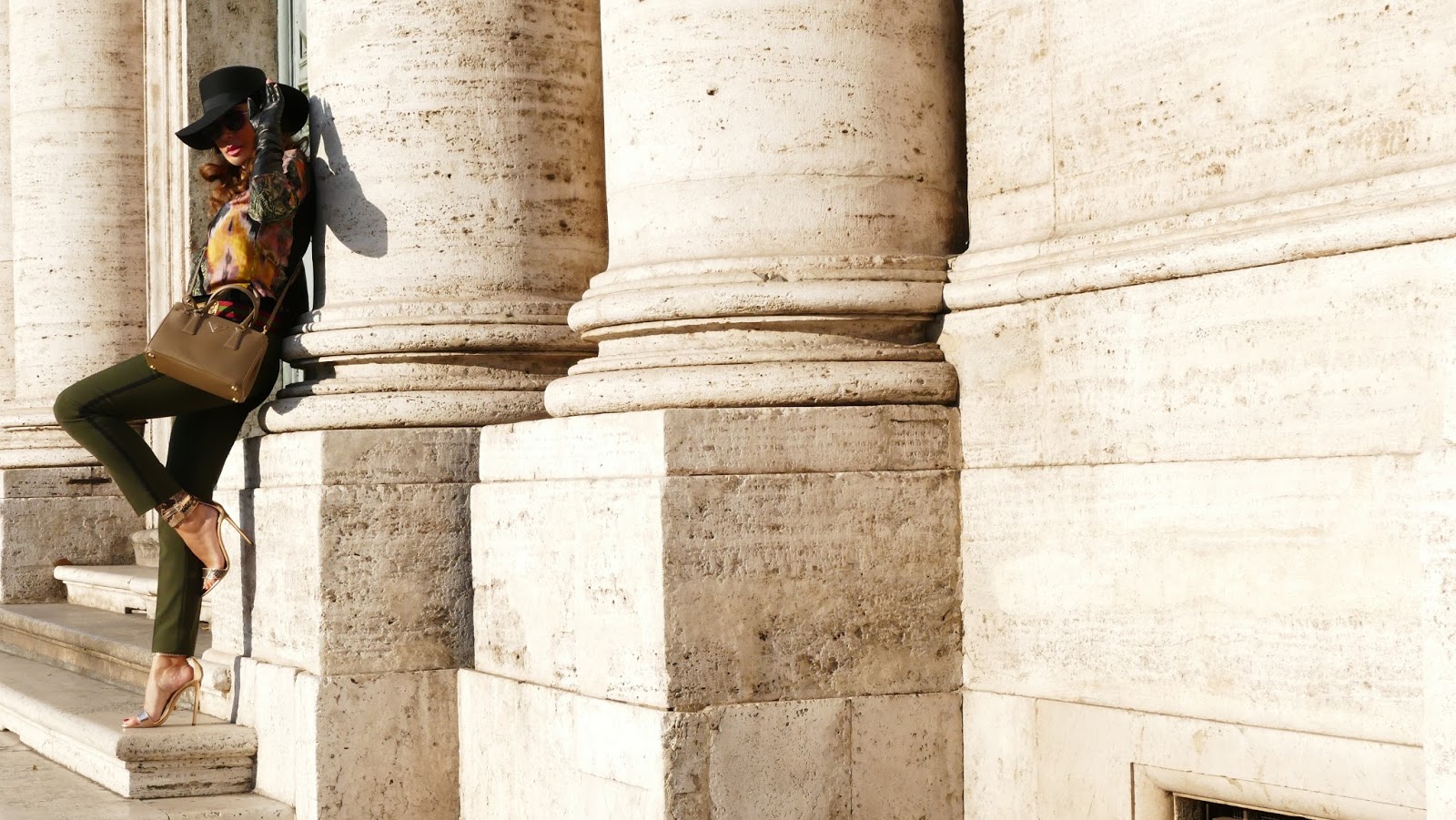
Singolare e duraturo nel tempo è il rapporto dei romani con l’acqua. Un rapporto che si palesa nella maestosità delle fontane capitoline.
L’acqua, indispensabile per la sopravvivenza umana, era l’elemento centrale della socialità dell’antica Roma, che amava incontrarsi alle terme.
Per i romani l’acqua era un dono divino ed ogni fonte aveva un nume tutelare, le ninfe.
Un’antica leggenda narra dell’amore tra la Ninfa Egeria ed uno dei sette re di Roma, Numa Pompilio.
Nel corso degli anni l’abbondanza di acqua del territorio, incanalata negli acquedotti, divenne l’occasione per manifestare il potere temporale della Chiesa, i cui reggenti, a vario titolo, proprio attraverso le fontane abbellirono la città, imprimendo il loro marchio.
I pontefici che restauravano gli antichi
acquedotti romani usavano realizzare delle fontane-mostra per
ricordare i loro atti di munificenza.
Fra
le molteplici opere che dobbiamo attribuire al pontefice Sisto V
Peretti, al secolo Felice Peretti, ve ne è una della quale andò talmente orgoglioso
che volle dargli il suo nome: l’acqua Felice, che egli portò a
Roma
ripristinando l’acquedotto Alessandrino. Questa fontana ne è
veramente
l’altare, davanti al quale ci troviamo in rispettosa
osservazione
comprendendo che si tratta della mostra della famosa acqua
dell’altrettanto famoso ed orgoglioso papa.
Fu eretta tra il 1585 ed il 1589, in marmo, breccia e travertino, la fontana presenta quattro colonne
ioniche, che scandiscono tre fornici chiusi; in corrispondenza delle
colonne ci sono quattro leoni che gettano acqua dalle bocche in tre
vasche, protette da una balaustra in travertino.
Tutta la fontana del Mosé è racchiusa dalla bellissima balaustrata
marmorea, mentre la nicchia centrale contiene la massiccia statua che dà
il nome alla fontana, il “Mosè”.
Nelle nicchie laterali, invece, si vedono due altorilievi, raffiguranti
episodi della bibbia connessi con l’acqua.
Un outfit effortless chic per assaporare un dolce clima romano che sa già di primavera, un top corto e un paio di pants a sigaretta, con il tocco deluxe del pellame degli accessori, perchè il pitone lo ritroveremo tra i grandi protagonisti della prossima P/E 2017.
(Clicca qui e qui per saperne di più sulla stampa pitone).
(Clicca qui per vedere tutti i miei precedenti post dalla capitale).
I pontefici che restauravano gli antichi
acquedotti romani usavano realizzare delle fontane-mostra per
ricordare i loro atti di munificenza.
Fra
le molteplici opere che dobbiamo attribuire al pontefice Sisto V
Peretti, al secolo Felice Peretti, ve ne è una della quale andò talmente orgoglioso
che volle dargli il suo nome: l’acqua Felice, che egli portò a
Roma
ripristinando l’acquedotto Alessandrino. Questa fontana ne è
veramente
l’altare, davanti al quale ci troviamo in rispettosa
osservazione
comprendendo che si tratta della mostra della famosa acqua
dell’altrettanto famoso ed orgoglioso papa.
Fu eretta tra il 1585 ed il 1589, in marmo, breccia e travertino, la fontana presenta quattro colonne
ioniche, che scandiscono tre fornici chiusi; in corrispondenza delle
colonne ci sono quattro leoni che gettano acqua dalle bocche in tre
vasche, protette da una balaustra in travertino.
Tutta la fontana del Mosé è racchiusa dalla bellissima balaustrata
marmorea, mentre la nicchia centrale contiene la massiccia statua che dà
il nome alla fontana, il “Mosè”.
Nelle nicchie laterali, invece, si vedono due altorilievi, raffiguranti
episodi della bibbia connessi con l’acqua.
Un outfit effortless chic per assaporare un dolce clima romano che sa già di primavera, un top corto e un paio di pants a sigaretta, con il tocco deluxe del pellame degli accessori, perchè il pitone lo ritroveremo tra i grandi protagonisti della prossima P/E 2017.
(Clicca qui e qui per saperne di più sulla stampa pitone).
(Clicca qui per vedere tutti i miei precedenti post dalla capitale).
Romans’ age-old relationship with their water is unique and eternal,
given the majesty of their aqueducts and, above all, their fountains.
A
fundamental of life, health and hygiene, water was the central-most
element of that ancient Roman society that socialized at the baths.
For the ancient Romans, water was indeed a gift from the gods, and every
H2O source had its own tutelary god or nymph. Such supersition can be
found as a component in numerous ancient myths, one being that of the
nymph Egeria, lover and wife of Numa Pompilius, one of the seven Kings of Rome.
In later centuries, the abundance of local water,
channeled through the aqueducts, became a means for the Catholic Church
to manifest its power on earth: still today we see the family crests of
the most powerful Popes branded onto many a Roman fountain.
The pontiffs restored the ancient Roman aqueducts to
realize the fountains-exhibition to commemorate their acts of
munificence.
Among
the many works that we must attribute to the Pope Sixtus V,
Felice Peretti, there is one of whom went so proud that he wanted to
give it its name: the “Aqua Felice”, which he brought to Rome by
restoring the aqueduct of Alexandria. This fountain it is really the altar before which we stand in
respectful observation realizing that it is the exhibition of the famous
water of the equally famous and proud pope.
It
was built between 1585 and 1589, with marble and travertine, the
fountain features four Ionic columns, which mark three arches closed; in correspondence of the columns there are four lions that spout water
from the mouths of three tanks, protected by a travertine balustrade.
The Moses’ Fountain is enclosed by the beautiful marble balustrade,
while the central niche contains the massive statue which gives its name
to the fountain, the “Moses”.
In the side niches, however, there are two high-reliefs, depicting scenes from the bible connected with water.
H2O source had its own tutelary god or nymph. Such supersition can be
found as a component in numerous ancient myths, one being that of the
nymph Egeria, lover and wife of Numa Pompilius, one of the seven Kings of Rome.
In later centuries, the abundance of local water,
channeled through the aqueducts, became a means for the Catholic Church
to manifest its power on earth: still today we see the family crests of
the most powerful Popes branded onto many a Roman fountain.
The pontiffs restored the ancient Roman aqueducts to
realize the fountains-exhibition to commemorate their acts of
munificence.
Among
the many works that we must attribute to the Pope Sixtus V,
Felice Peretti, there is one of whom went so proud that he wanted to
give it its name: the “Aqua Felice”, which he brought to Rome by
restoring the aqueduct of Alexandria. This fountain it is really the altar before which we stand in
respectful observation realizing that it is the exhibition of the famous
water of the equally famous and proud pope.
It
was built between 1585 and 1589, with marble and travertine, the
fountain features four Ionic columns, which mark three arches closed; in correspondence of the columns there are four lions that spout water
from the mouths of three tanks, protected by a travertine balustrade.
The Moses’ Fountain is enclosed by the beautiful marble balustrade,
while the central niche contains the massive statue which gives its name
to the fountain, the “Moses”.
In the side niches, however, there are two high-reliefs, depicting scenes from the bible connected with water.
My effortless chic outfit is perfect for the sweet Roman climate that already smells of spring, a cropped top and cigarette pants, with the
touch of deluxe leather accessories, because the python will be
among the great protagonists of the next SS 2017.
touch of deluxe leather accessories, because the python will be
among the great protagonists of the next SS 2017.
(Click here to see the most beatiful snake print pieces from Balmain SS collection).
(Click here to see all my previous posts from Rome).
Location: Quirinale District – Fountain of Moses – Rome- Italy












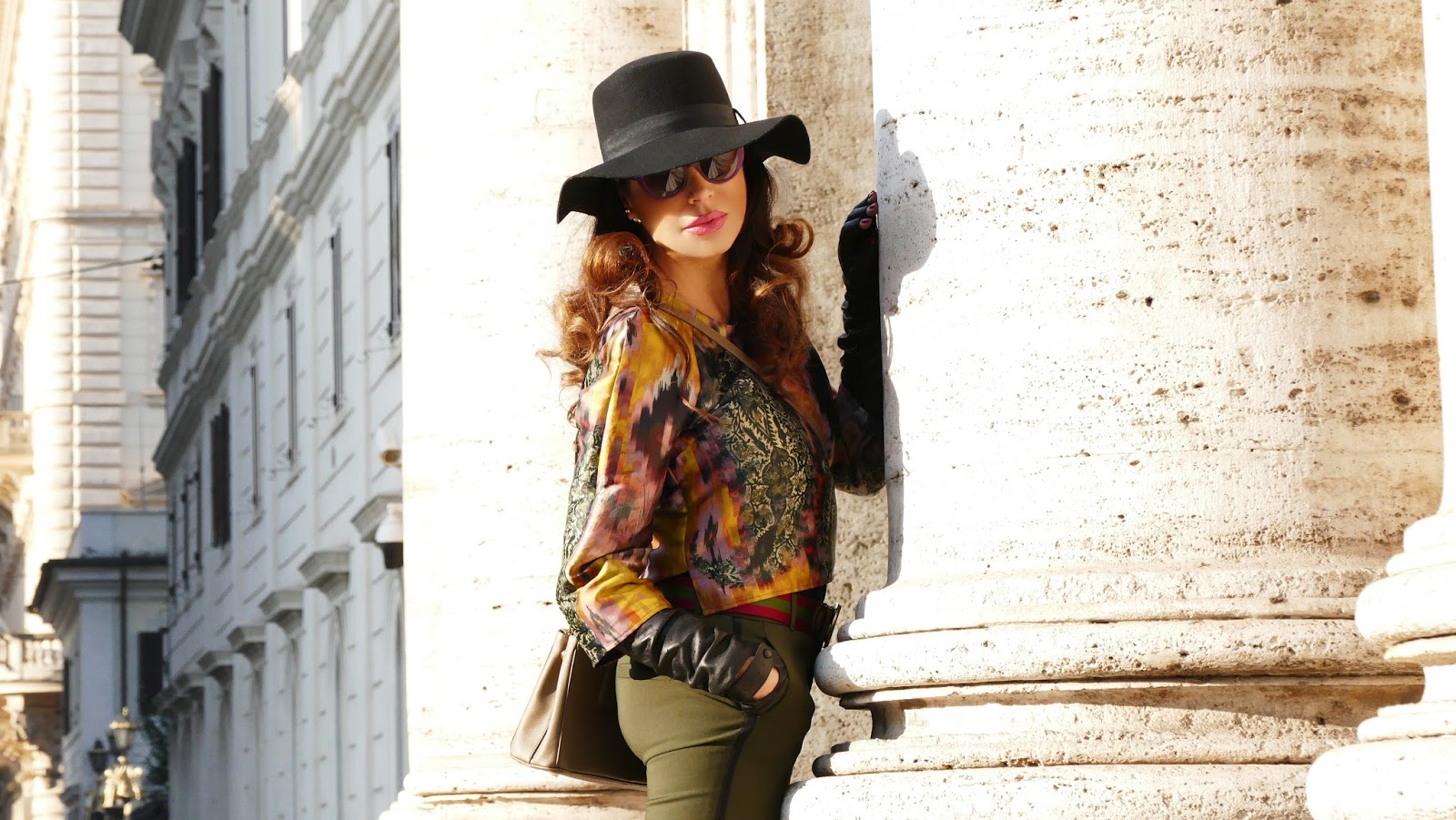

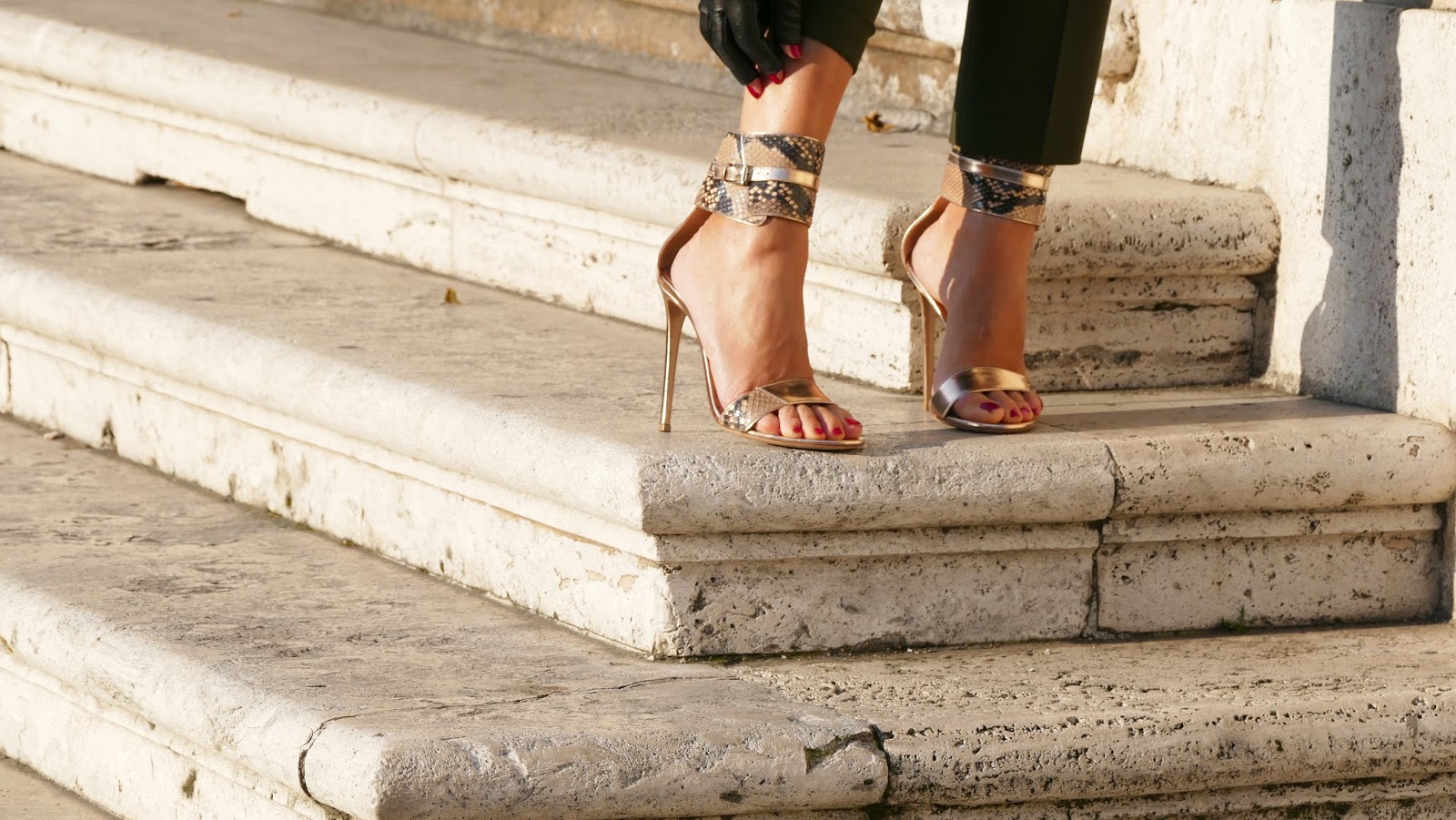
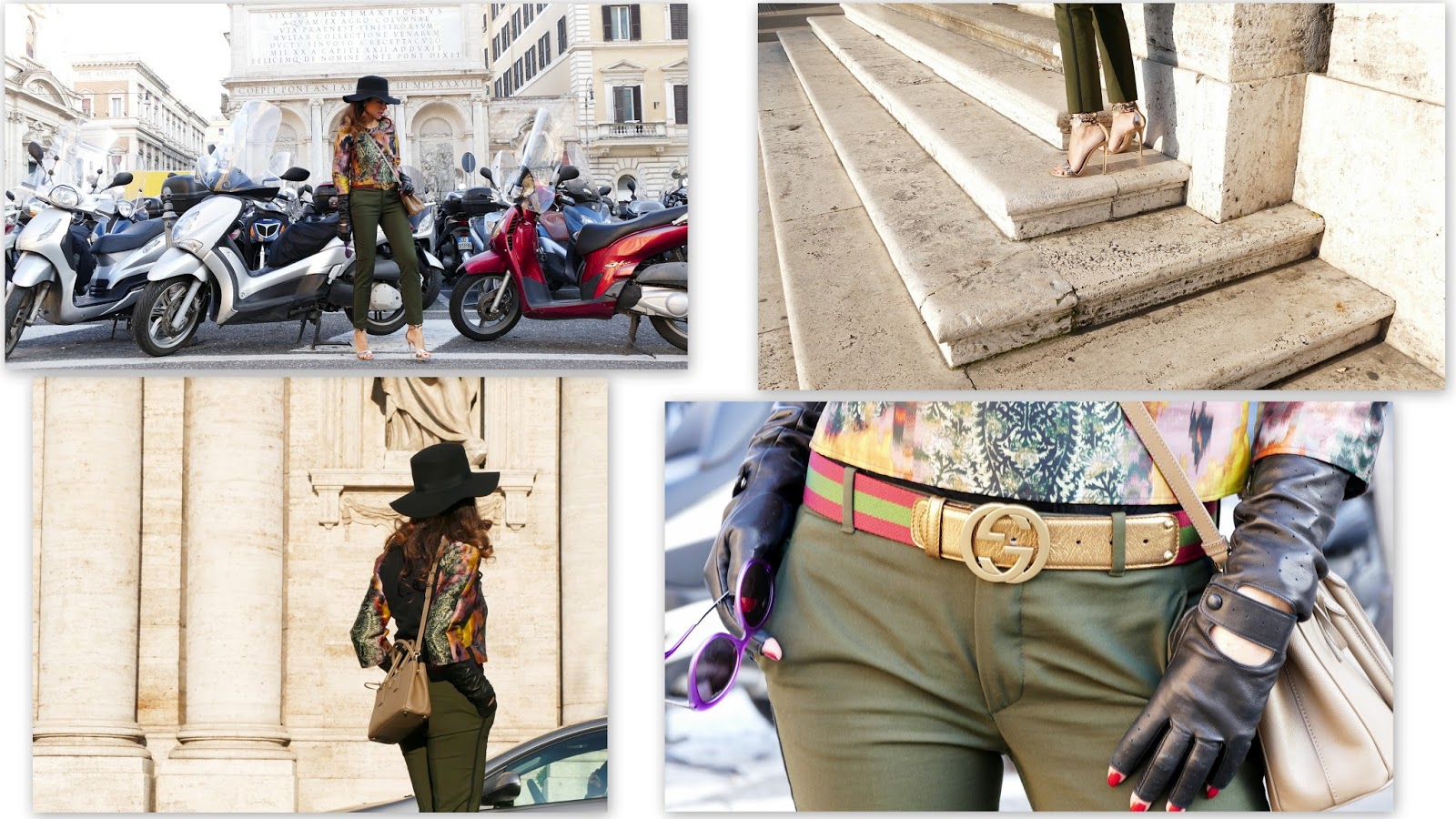


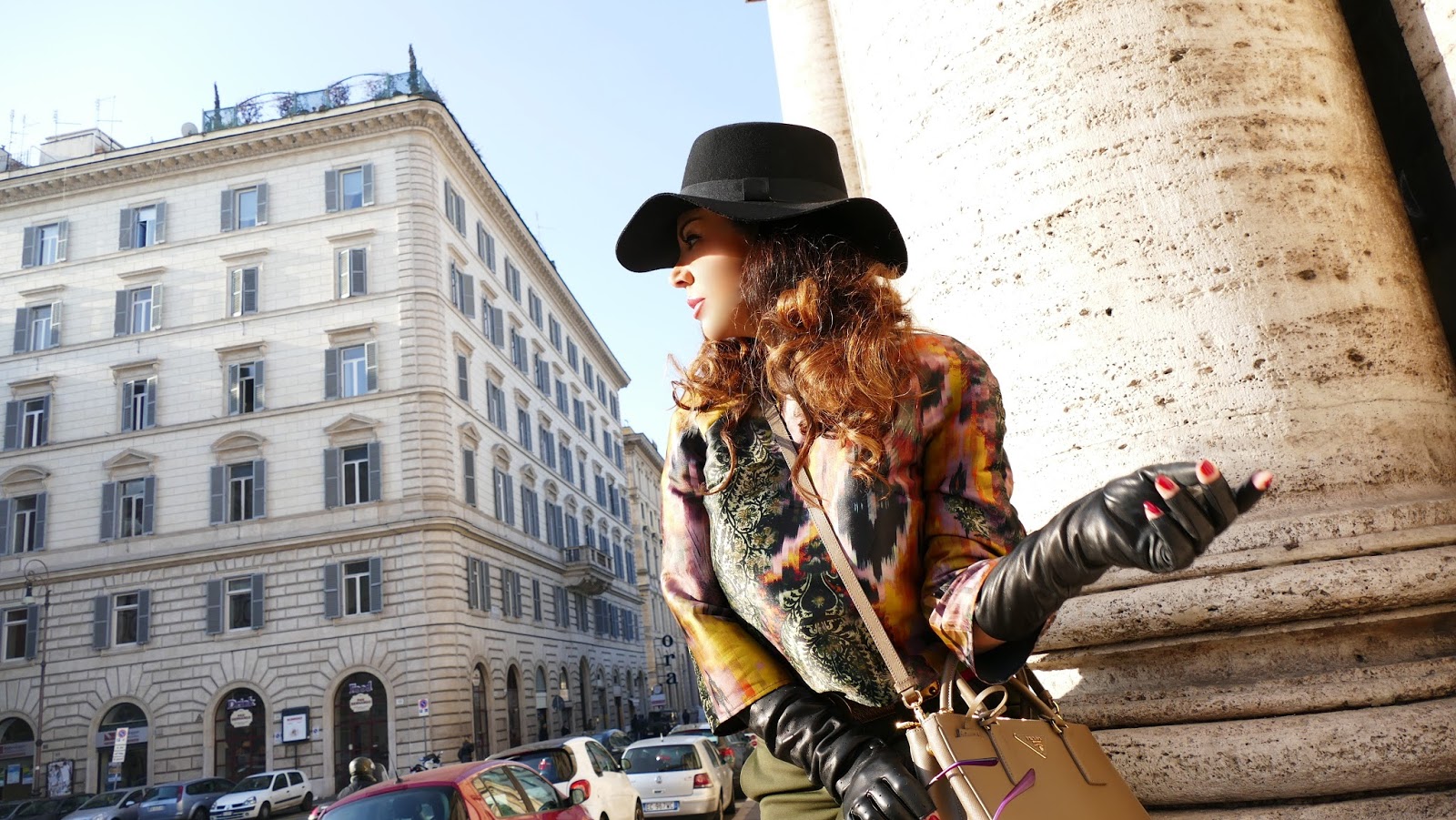
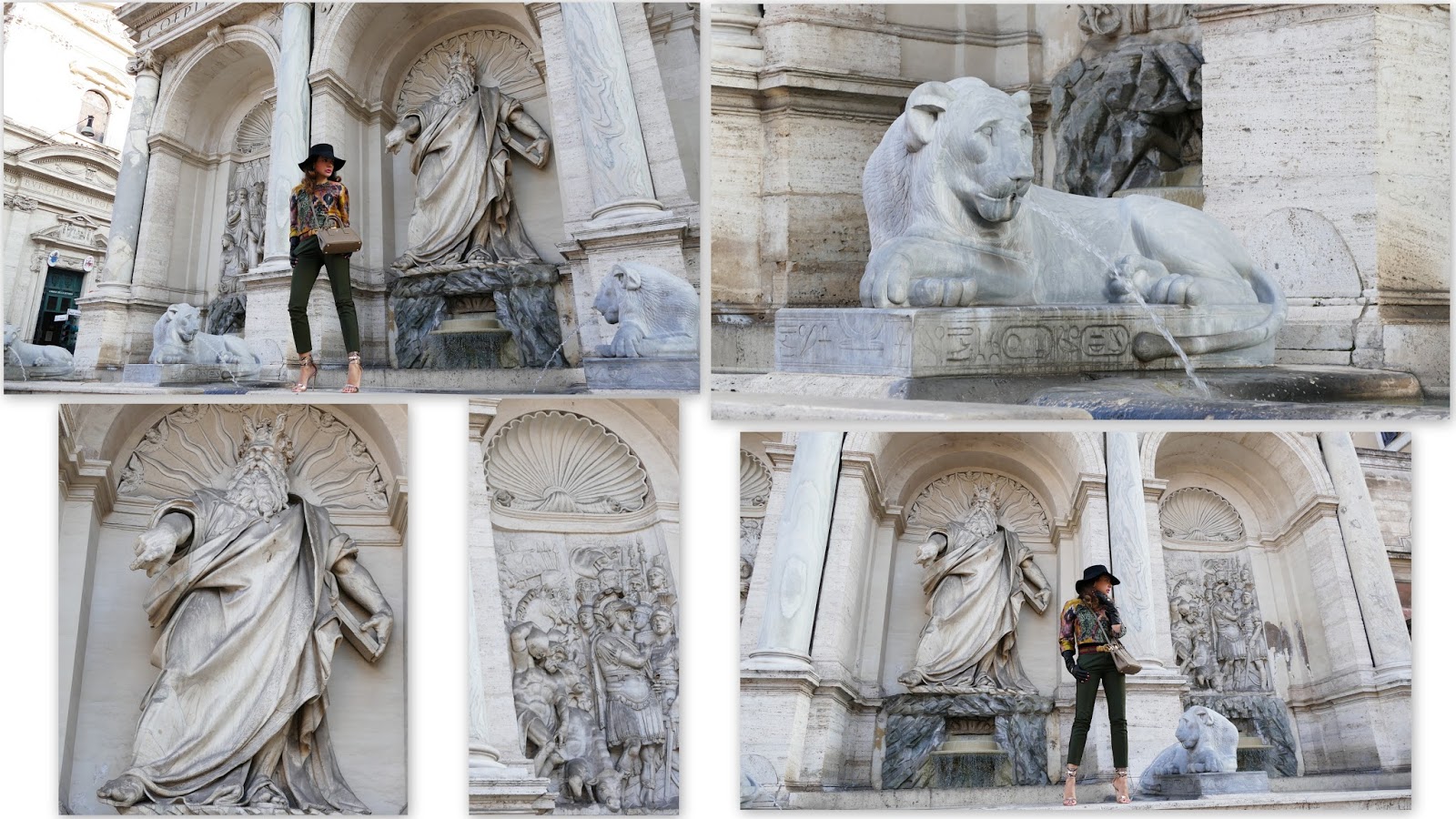
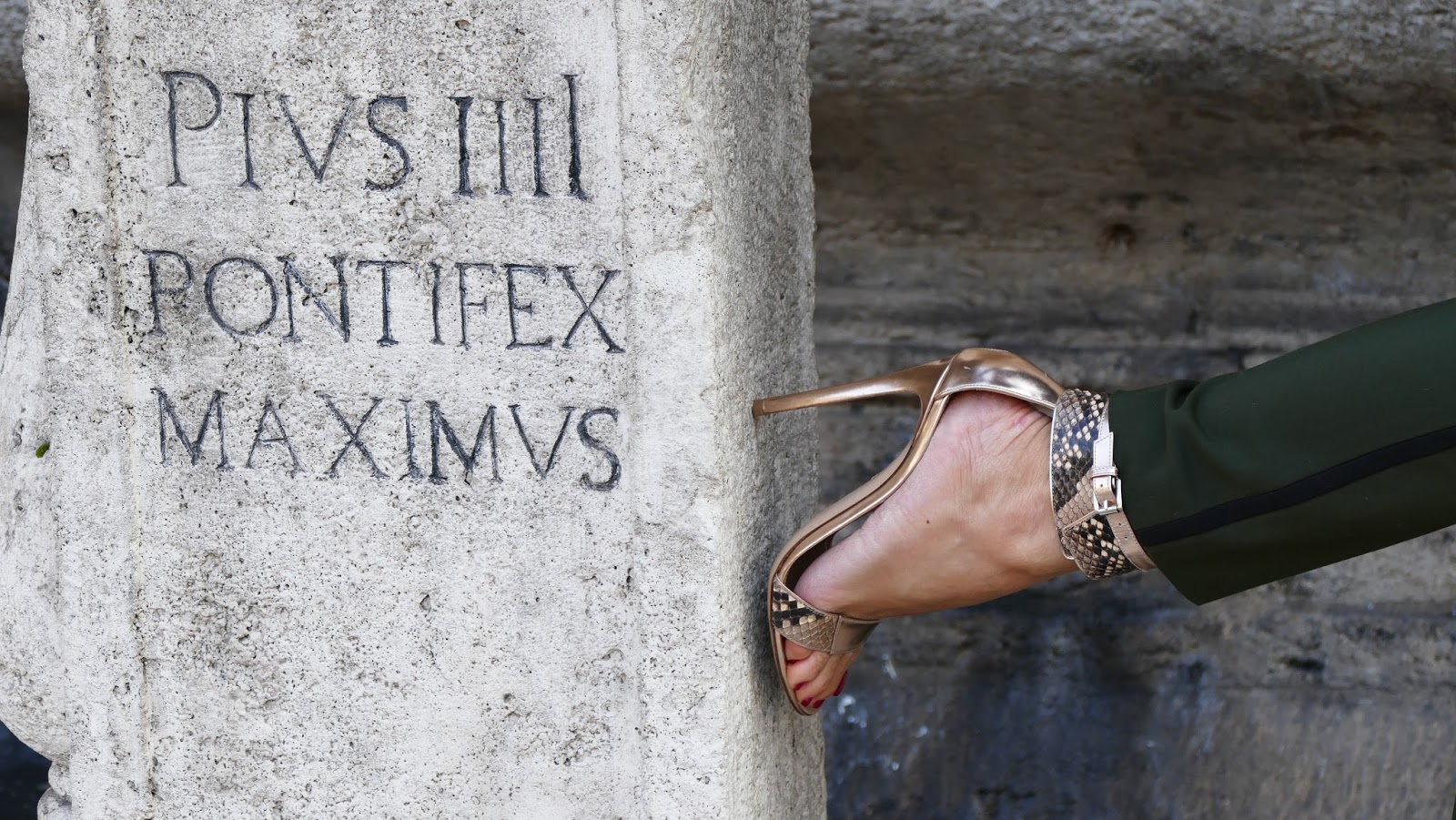
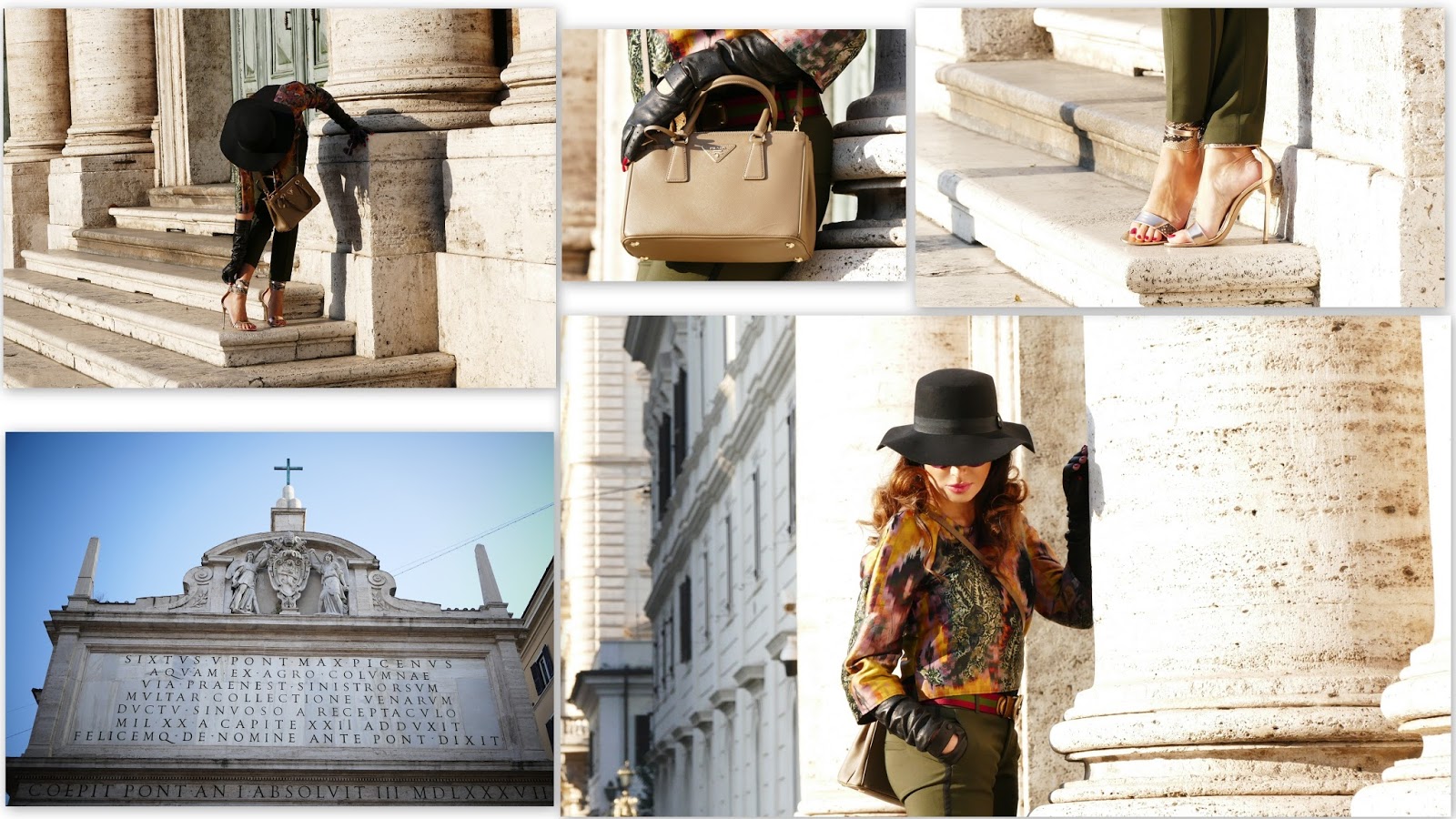
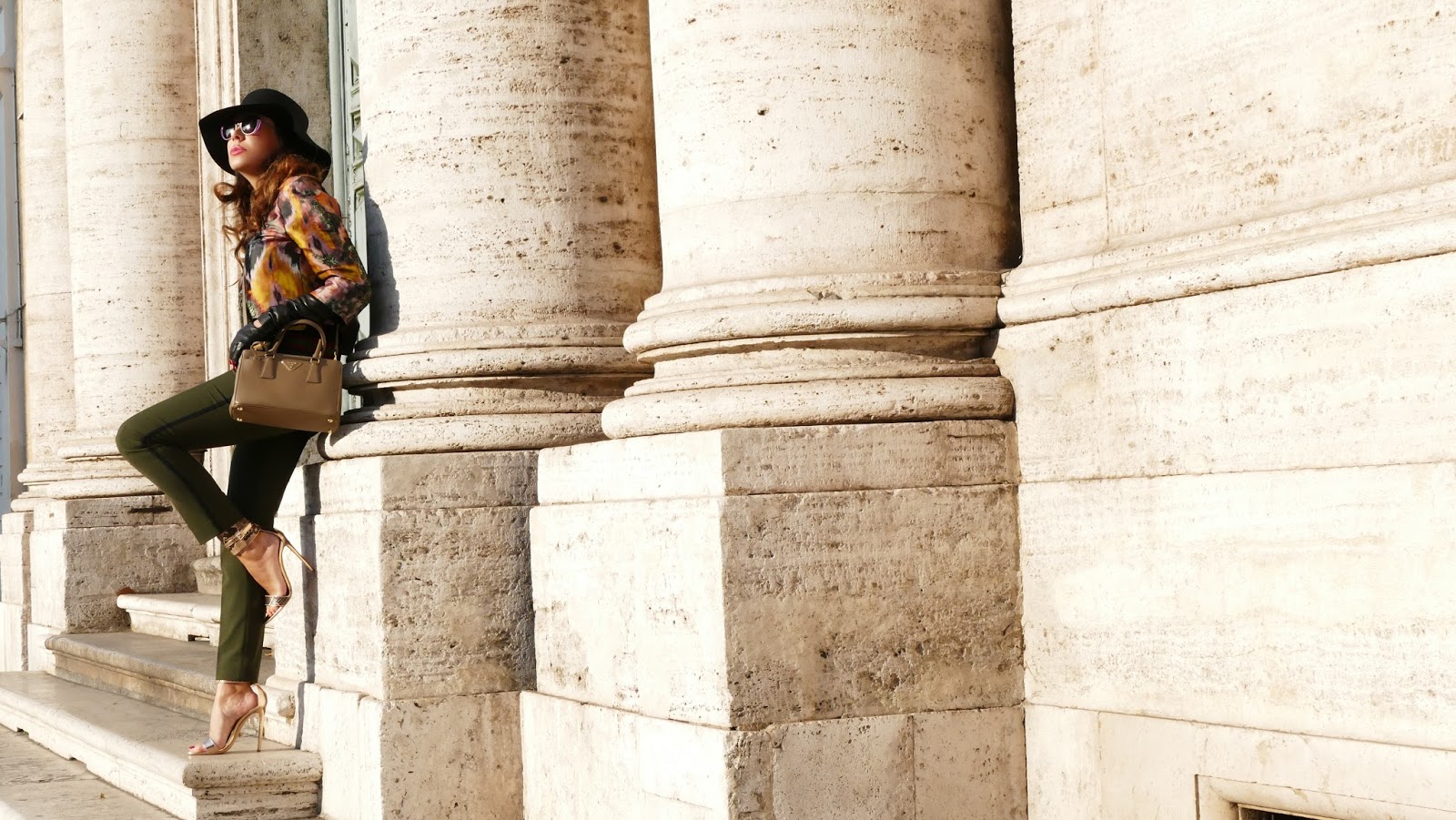
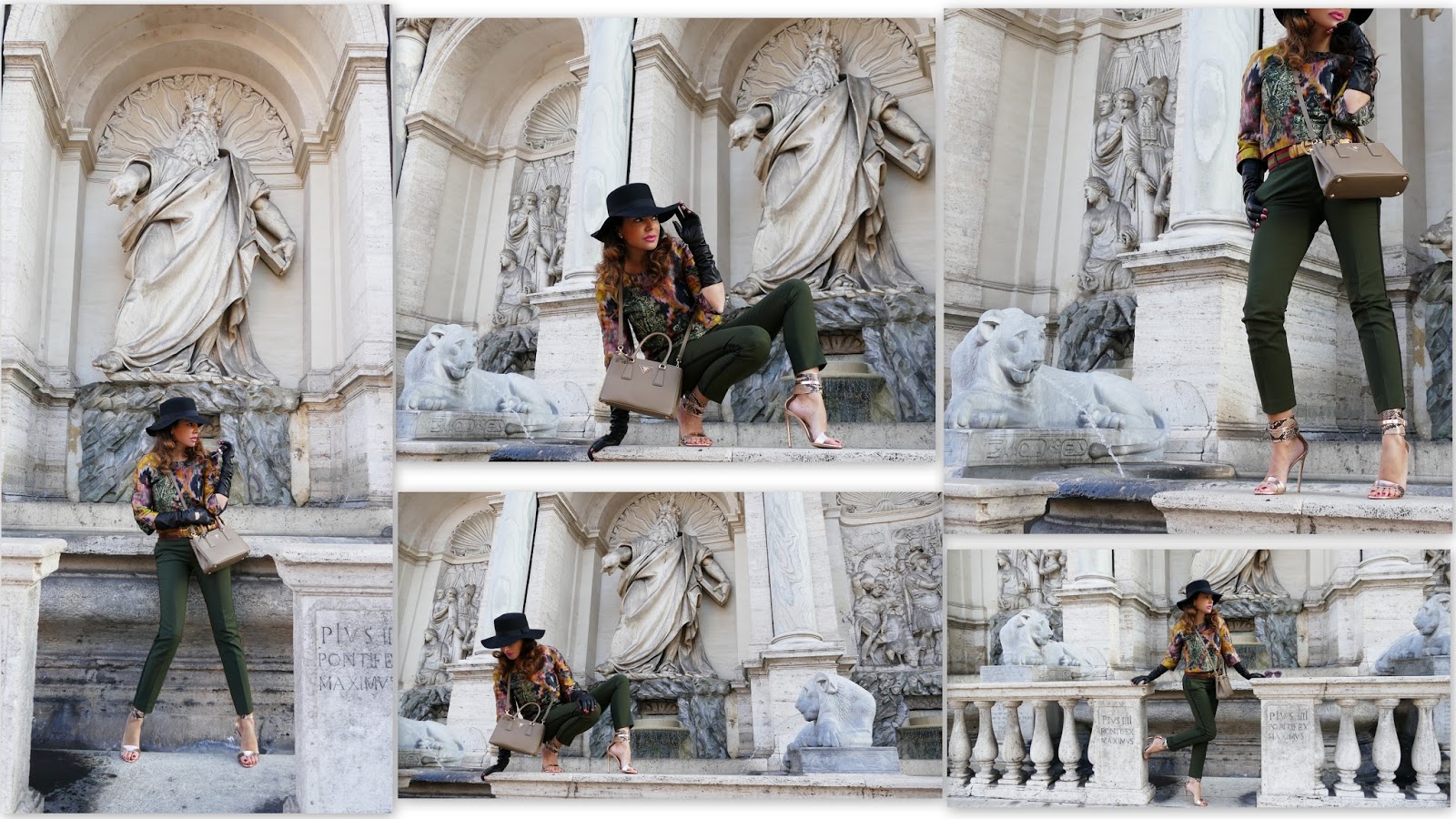
Photos: GerardoFusco.it
I was wearing:
Le Ragazze di Saint B. top
Zara gloves and trousers
Vogue sunglasses
Gucci belt
Prada bag
Gianvito Rossi sandals



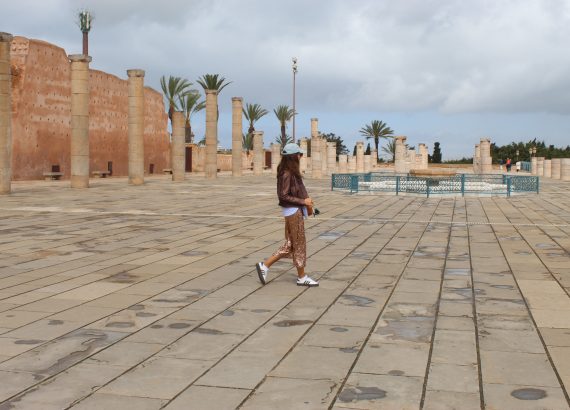
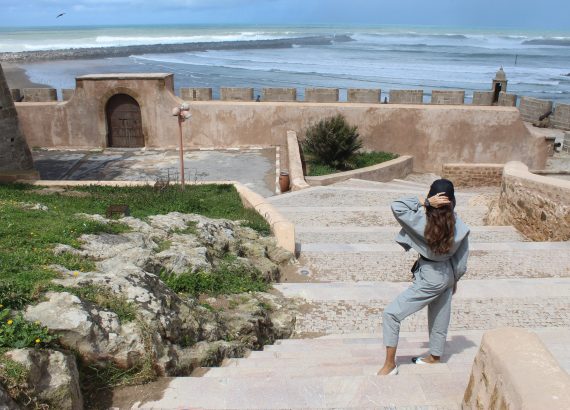
beautiful!!! amazing look! 🙂
omg so amazing photo <3 i love your style
http://wooho11.blogspot.com/ – i invite <3 follow me-will respond with
Love this look – especially the top is amazing!
http://martasfashiondiary.com/denim-over-the-knee-boots/
Enjoyed reading the post. The outfit is gorgeous. Love the heels, the hat, the top everything is just fab !
Lippie143.blogspot.com
chic and elegant- I like so much those all colors on you Paola. Again you nail it 🙂
xx
Those fountains are so iconic! Looks like you had fun there Paola!
Fabulous! Love the outfit and setting; great images.
Have a blessed week darling!
Funmi xx
http://www.funmialabi.co.uk
Sei splendida Paola con questi colori caldi in contrasto con il travertino bianco. I sandali sono spettacolari! Baci, Valeria – Coco et La vie en rose FASHION & BEAUTY
Come sempre indossi un look perfetto, ma quei sandali sono un sogno! Kiss
Nuovo post “La musica ci salva sempre” sul mio blog http://www.littlefairyfashion.com
Such amazing photos. You look great!
Come sempre uno spettacolo le tue foto e tu sei più solare di sempre! baci
Sei sempre stupenda!
LA BORSA DI MARTINA
Questi colori sono meravigliosi…..e tu sei sempre splendida!!!!
Un abbraccio grande!!!
Marta
http://www.lagattarosablog.it
Thanks a lot 😀
OMG you always have the best outfits!
NEW GET THE LOOK POST | Cool Looks Are The New Black.
Instagram ∫ Facebook Oficial Page ∫ Miguel Gouveia / Blog Pieces Of Me 😀
i sandali sono divini, adoro il colore oro
Amazing style dear!♥
New post on my blog: http://vesnamar.blogspot.rs/2017/02/spring-hurry-up.html
Thanks babe!
xoxo
One of the things I love finding through Europe (various parts) are aqueducts. They're so magestic and still standing after so many years. Just wonderful
Sxx
http://www.daringcoco.com
Che colori Paola! Mi piace un sacco il top, ti dona tanto! Buon inizio settimana, un bacio!:*
What beautiful pictures and style!
Have a lovely day 🙂
Rosanna x
Rose's Rooftop
Your shoes are fantastic, beautiful. Have a wonderful day lovely xx
E niente, queste foto in giro per Roma sono una più bella dell'altra! Altro look azzeccatissimo, combo di colori particolarmente chic!
Un bacione! 💕 F.
La Civetta Stilosa
Bellissimo look
un bacione
admaiorasemper.website
Super gorgeous Paola,
In love with your sandals.
Emma
http://www.emmalovesfashion.com
You look stunning in those outfits…
Also check top rated coupons by Fivestarcoupon.com
I need those shoes in my life! LOL amazing pics and amazing place
kisses my dear
http://www.aprendiendoaquererme.com
innamorata dei sandali con belli e particolari!
Kisses darling
Bellezza pour femme – fashion blog di Marzia Amaranto
Che foto fantastiche!! Sei stupenda! 😉
Un bacio
Agnese & Elisa
http://desiresinstyle.com/
wow, que fotos más increibles!
Muchas gracias por tu comentario en mi blog bonita mia, te espero por mi nuevo post, mil besos!
http://patriciasanchezstylestreet.blogspot.com.es/
Bellisima great outfit.
Stupendi questi sandali !! Bellissima !!
http://www.glitterchampagne.com
Gorgeous everything! Especially you and this time the gloves cought my attention. Perfecto, bellissima!
Absolutely in love with these sandals!
xx
http://www.mybeautrip.com
Damn, those poses! love them. The buildings are beautiful.
Bernie, xx
The Style Fanatic
Cherie io vedo la maestosità della tua bellezza e la bravura nel creare solo outfit impeccabili
baci
http://unconventionalsecrets.blogspot.it
You always look fabulous!
http://www.effortlesslady.co
Wow,what a perfect outfit �� You look stunning !!
You are superbly gorgeous, as always! The images are adorable. Great post dear))
Kisses darling!
Thanks a million Oksana!
conosco quella fontana, molto bella, non ne conoscevo la storia!
bacio
Lalu
Great post! Thanks!
che meraviglia questa blusa, ha una stampa e una linea stupenda
buon inizio settimana, un abbraccio
<<< tr3ndygirl fashion blog >>>
Non solo per i romani, bella Paola, l'acqua eh ancora oggigiorno un articolo di lusso in molti luoghi! Mi piace moltissimo, bevo molta acqua durante il giorno! Una delle mie bisnonne eh natta a Roma 🙂 Forse mi piace l'acqua tantissimo per questo 🙂 Sei sempre bellissima, con questo top meraviglioso e le sandale super chi e delicate! Mi piace molto la borsa e sempre sei molto bella, elegante e super femminile! Baci, una bella settimana per te!
DenisesPLanet.com
Wow q fotos tan lindas y tu bolso todo un amor 🙂
http://www.elblogdesilvia.com/2017/02/streetstyle-nyfw-jonathan-simkhai-zara-fashion-show-blogger-influencer.html
Besitos
beautiful outfit Paola i would totally wear this outfit as usual you know im obsessed with your shoes and handbags lol
I nominated you for the liebster award on my blog!!
http://www.mssparkleandglow.com
Oh my goodness your photos are so gorgeous and you look stunning in each one!
Danielle | FollowMyGut.com <3
Fantastico questo look, i sandali meravigliosi!
Alessia
Thechilicool Facebook Instagram
Kiss
Great post! Thanks!
Questo è un look che trasmette tutto ciò che sei: bellissima, sensuale, di classe e favolosa.
Un bacione
Maggie Dallospedale
Indiansavage.com
those photos look like out of VOGUE 🙂
THE FASHION MATTERS- Travel & Fashion blog | INSTAGRAM: TheFashionMatters
You look incredible darl. Those heels are beyond x
♥Kumari
http://stylesociety.co.za
Bellissime foto!
Baci
Blery&Ily
http://www.thesprintsisters.com